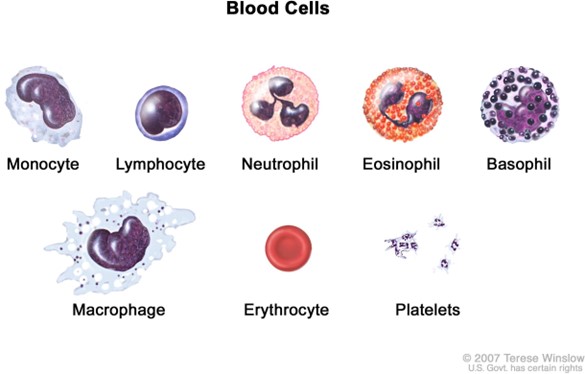While looking at a sample of blood in a microscope, you see a purple-stained cell that is markedly larger than a red blood cell (about two to three times larger).
It has a large kidney-shaped nucleus.
What type of blood cell is this?
Monocyte.
Basophil.
Neutrophil.
Eosinophil.
The Correct Answer is A
A monocyte is a type of white blood cell that is markedly larger than a red blood cell and has a large kidney-shaped nucleus.

Monocytes are involved in defending the body against infectious diseases and foreign materials.
Choice B is wrong because a basophil is a type of granular white blood cell that has a lobed nucleus and stains purple with basic dyes.
Basophils are involved in allergic reactions and inflammation.
Choice C is wrong because a neutrophil is a type of granular white blood cell that has a multilobed nucleus and stains pale pink with neutral dyes.
Neutrophils are involved in phagocytosis and killing bacteria.
Choice D is wrong because an eosinophil is a type of granular white blood cell that has a bilobed nucleus and stains red-orange with acidic dyes.
Eosinophils are involved in combating parasitic infections and allergic responses. The normal ranges of different types of blood cells are:
Red blood cells: 4.5 to 5.9 million per microliter (mcL) for males, 4.1 to 5.1 million per mcL for females
White blood cells: 4,000 to 11,000 per mcL for both males and females
Platelets: 150,000 to 450,000 per mcL for both males and females
Nursing Test Bank
Naxlex Comprehensive Predictor Exams
Related Questions
Correct Answer is A
Explanation

It is a major component of the lymphatic system and contains T and B lymphocytes.
Choice B is wrong because the spleen does not produce T lymphocytes, but rather stores them.
T lymphocytes are produced in the thymus.
Choice C is wrong because the spleen does not filter lymph, but rather blood. It traps bloodborne microbes and produces an immune response to them.
Choice D is wrong because the spleen consists of one lobe and is located in the upper left abdomen below the diaphragm.
The description in choice D matches the thymus, not the spleen.
The normal size of the spleen in adults is about 12 cm long, 8 cm broad, and 3-4 cm thick, weighing about 200 g.
The normal range of splenic index (the product of length, width, and thickness) is 120-480 cm.
Correct Answer is B
Explanation
Circulation is the movement or flow of something, especially blood or air, through a circuit or a specific course.
Circulation supplies oxygen and nutrients to and removes wastes from tissues. This is essential for the survival and functioning of cells and organs.
Choice A is wrong because circulation does not inflate the lungs.
The lungs are inflated by the pressure difference between the air inside and outside the chest cavity.
Choice C is wrong because circulation does not deliver waste to tissues.
Circulation removes wastes from tissues and delivers them to the excretory organs such as the kidneys and the lungs.
Choice D is wrong because circulation does not deliver carbon dioxide to tissues and removes excess oxygen.
Circulation does the opposite: it delivers oxygen to tissues and removes carbon dioxide.
Carbon dioxide is a waste product of cellular respiration that needs to be eliminated from the body.
Whether you are a student looking to ace your exams or a practicing nurse seeking to enhance your expertise , our nursing education contents will empower you with the confidence and competence to make a difference in the lives of patients and become a respected leader in the healthcare field.
Visit Naxlex, invest in your future and unlock endless possibilities with our unparalleled nursing education contents today
Report Wrong Answer on the Current Question
Do you disagree with the answer? If yes, what is your expected answer? Explain.
Kindly be descriptive with the issue you are facing.
